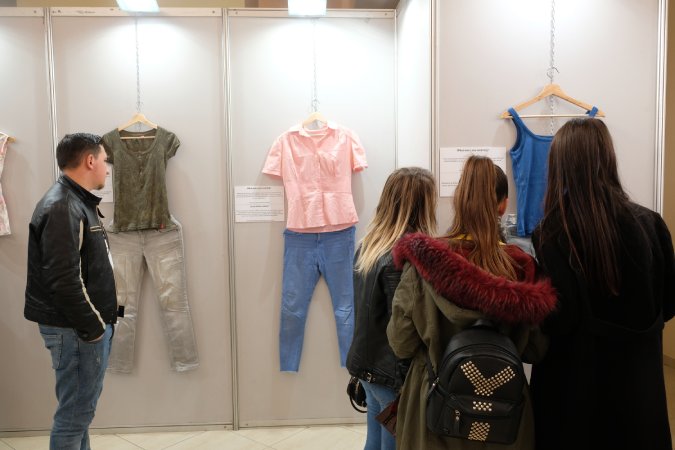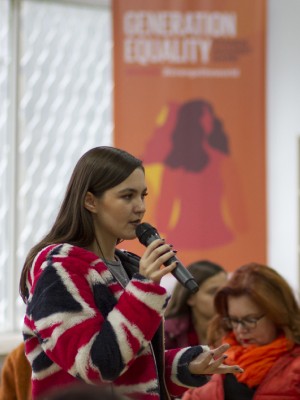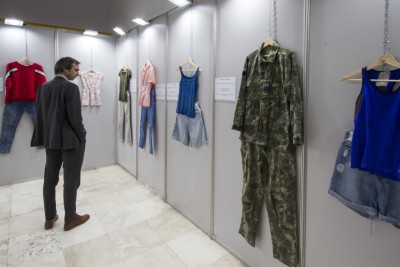“What were you wearing” Clothes exhibition seek to end blaming of rape survivors
Date:

25 November 2019- UN Women in Albania in collaboration with the student campus and Municipality of Tirana opened the art installation called “What were you wearing”, a clothes exhibition built around the testimonials of survivors of rape. Representatives of the student campus, Tirana Municipality and the Ombudsperson Office were present at the opening ceremony. The Student City is the biggest student resident center in Albania with nearly 5000 students every year.
“Everybody agrees that violence against women is a huge problem, and we must discuss widely around this issue. In Albania 1 in 2 women report to have been violated sometime in their lifetime, while 2 in 10 women have experienced sexual harassment and furthermore 1 in 10 women have been sexually abused. Rape is a very complicated and delicate topic, but the message we want to give through this exhibition is that besides breaking the silence, we should also stop blaming the victims and start listening to them,”- said Michele Ribotta , UN Women Representative to Albania.

Inspired by the poem “What I Was Wearing” by Dr. Mary Simmerling, in 2013 Dr. Mary Wyandt-Hiebert (University of Arkansas) and Ms. Jen Brockman (University of Kansas) developed the Installation’s concept and collected donated descriptions from survivors of what they were wearing when they experienced sexual violence. These descriptions were used to recreate the outfits worn during the assaults for the installation. The first “What Were You Wearing?” Survivor Art Installation was displayed at the University of Arkansas in 2014. Since the installation speaks to a universal experience of victim- blaming and rape culture, it has been replicated in many countries by organizations and universities.
The question, ‘What were you wearing?’ was pervasive for most survivors. To ask the question, “what were you wearing?” cost the questioner nothing, there is no sense in making this statement since sexual assault is not defined by what the victim was wearing. However, the survivor must pay dearly in not only their answer; but also, in the burden of self-blame.
Deputizing for the Ombudsperson Office, Mrs. Vilma Shurdha, Commissioner for Women and Children’s’ Rights said violence against women represents one of the heaviest violations of human rights. “We should all cooperate, state institutions, media and civil society to prevent this violence. The Ombudsperson Office remains committed to supporting any initiative that contributes to the improvement of the legal framework on the matter.”
After visiting the exhibition, the students took part in a discussion forum moderated by two fellow students. The main aim of the discussion was to encourage debates and reflections on the theme of rape, factors that motivate it, the profile of perpetrators and the position of survivors.

“In this exhibition, I saw myself along with the immediate need to reflect about this topic,” said one student. Another student emphasized the significance of education on gender equality, including sexual health and abuse. “Until high school, I had zero information about sexual abuse, and I felt very unprepared to face these situations. We should give pupils more information about the topic.”
“I understood that no clothing, age or beauty is a factor when it comes to rape. The only factor is the perpetrator”, said another student.
A Police Service Representative, Counseling Line for Men and “Sot per te ardhmen” NGO were present during the discussion and informed students about the national counseling line 116117, the procedures on how to report sexual assaults and the institutions that offer support.
“I ask you not to be indifferent. There is no law that protects us from the indifferentism,” said Mrs. Arta Mandro, a resident at the Student City, lawyer, professor and activist. “Everybody is vulnerable to the violence, but together we can be less vulnerable. We need you to go to your families and stand for equality because you are generation equality!
The installation was also displayed in Elbasan, at “Aleksander Xhuvani” University, followed by a discussion on the topic with more than 80 students. Both exhibitions were supported by the UN joint programme on Eding Violence Against Women in Albania, with funds from the Swedish Government.